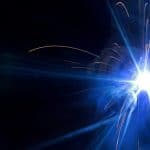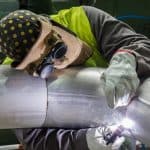As an Amazon Associate I earn from qualifying purchases through links from this site. See the disclosure page for details.
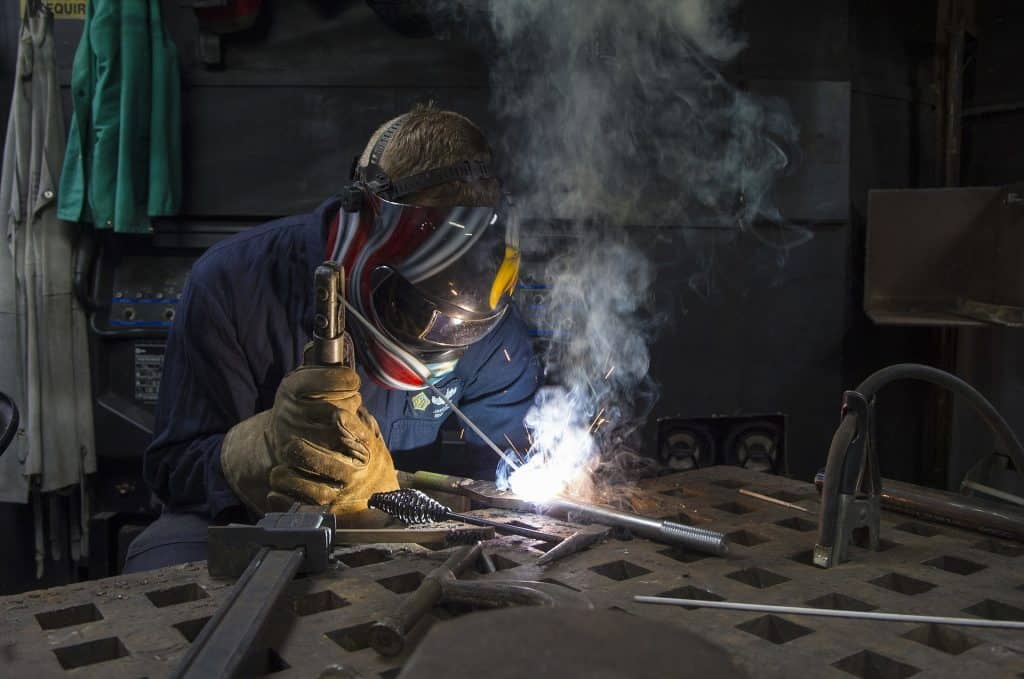
Which welding tools do you need?
I’m sitting here in my workshop and wondering, what kind of equipment and tools for welding do you actually need?
Among welders, there are so many different opinions about what welding tools and equipment is useful and required. So I did a little research.
The most important things to weld properly is a welding machine and an angle grinder. Moreover, you need welding pliers, a welding square, clamps, a chipping hammer, a wire brush, metal file, tape measure, and a soapstone pencil. Concerning safety equipment, you should have a welding helmet, a welding jacket and trousers, welding gloves, safety goggles and a fire extinguisher.
So let’s take a closer look at what equipment and tools are beneficial for welding.
What electric power tools do you need for welding?
Welding machine
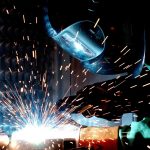
MIG welder
Of course, the welding machine is the most crucial tool for welding. You need a welding machine that suits your welding job. The main welding technologies between you can choose are MIG-, TIG-, Stick- and Oxygen-Acetylene welding. Each technology has its advantages and drawbacks which I don’t want get in detail right here.
You can either buy a welder or rent one at, e.g., Home Depot or Lowes.
The welding machine should be complete with its accessories like the cart, ground clamp, consumables (for example welding rods, shielding gas), cables, hoses and suited power plug. Take care: some machines are good with 110 V while others require an input voltage of 220 V.
If you are off the power grid, buy an engine driven welder-generator.
Angle grinder

angle grinder
For preparation and finish work you always should have an angle grinder with you. Use different attachments and discs on your grinder to cut, clean, finish or create new looks on your workpiece.
Some people say besides a welder, the angle grinder is your most important tool for welding. An angle grinder is quite a versatile tool for prep and finishing works.
For example, you can sharpen the edges of your hand tools, cut your workpiece in size and clean the weld area. After your weld job, you can use different discs to remove burrs, to finish the surface and clean the weld seam.
back to menu ↑What hand tools for welding do you need?
When it comes to hand tools for welding, I agree to most of the people that you need at least the following tools:
Welding Pliers
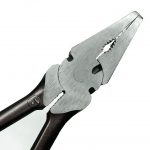
A good pair of welding pliers (some call it Welpers) are welding tools no welder should be missing. With multi-functional MIG welding pliers, you can remove weld spatter inside your nozzle or clean your workpiece. Moreover, you can use it as a slag hammer. Also, welding pliers make it easy to draw out wire or cut the wire when you are MIG welding. Last but not least you can install your welding nozzle with this handy tool.
Chipping hammer
 A slag hammer or chipping hammer is a tool you can use to remove welding slag from a weld seam.
A slag hammer or chipping hammer is a tool you can use to remove welding slag from a weld seam.
Slag comes from the flux which melts during the welding. The slag on top of the weld seam needs to removed before you add another weld layer or before you add any other surface finish. Usually, a slag hammer is only required for arc welding, because MIG and TIG welding does not produce slags.
Wire brush
First of all, a wire brush is useful to prepare your workpiece before welding. Remove dirt, old paint, and rust. If it sticks hard, use your angle grinder to assist.
Second, after you have finished your weld seam and removed the slag, you can remove spatters and leftovers with the wire brush. Keep in mind to use the correct material combination of wire and workpiece. Otherwise, it can happen that there will be rust on top of your stainless steel workpiece because of your wire brush.
Vice grips and clamps
To hold your workpiece in place vice grips and clamps (C-clamps) do a good job.
Metal file
For quick deburring or edging of metal pieces, a metal file is a tool for welding you also should consider.
During my recherche, I learned that it is recommended to buy quality files, use chalk and not to backstroke them. When you keep them clean, dry and rust-free, you will be amazed how well you can finish parts with a file.
back to menu ↑Useful measurement and marking tools for welding
Of course, sometimes you have to measure the length of your workpiece and mark where to cut or weld it. Some measurement tools that assist you with that jobs are as follows:
Pencil
Use your favorite pen like a sharpie pen, paint pen or soapstone to mark relevant areas or to draw lines. Soapstone is preferred for rough marking, while welder pencils are good for fine lines.
Welding Square
Another useful tool for welding is the welding square. Use the welding square to hold workpieces correctly and adjust them before clamping or marking them.
Caliper / Gage
Use a dial or digital vernier caliper for smaller engineering tasks. Some welders also use a protractor and welding gage set.
Use a sheet metal gauge to identify metal sheet thicknesses.
back to menu ↑What protection clothing and equipment is required for welding?
Welding helmet
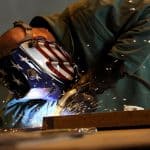
Cool welding helmet
A good welding helmet protects your face and eyes from the welding process. High intense UV rays from the welding process can cause arc eye, Cataracts and fatigue your eye. In extreme cases exposition to UV rays also can lead to blindness.
To protect yourself from the high-intensity light, you should even take a look at auto-darkening welding helmets. An auto-darkening welding helmet instantly darkens upon within the fraction of a second when the sensor is exposed to the welding arc. When you are not welding, the shade of the darkening filter is clear to see through. There are even welding helmets that make you look cool.
As an alternative, consider welding caps and hats.
Welding gloves
Welding gloves are essential in protecting hands from extreme heat, electrical shock, and infrared/ultraviolet radiation. Usually, welding gloves are made of cotton or leather.
When buying, look for the right balance of protection and flexibility. To weld correctly, moving your hand and providing a reasonable level of dexterity is essential to receive a solid weld seam.
Welding jacket and trousers
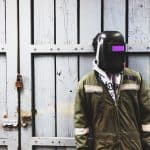
Leather welding jacket
Believe me. You don’t want hot molten metal to drip on your jeans. Therefore, lightweight welding trousers and welding jackets protect your skin from getting hurt and are comfortable to wear at the same time.
Clothing for welding is usually made out of leather or special fire retardant cotton or nylon. The leather for jackets is usually made of boarhide, cowhide or pigskin. Premium equipment advertises flame resistant carbonized fiber fabric. Even more, some welding clothing is sewn with Kevlar thread to provide even higher durability.
Safety goggles
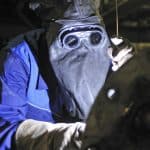
welder with goggles
Choose between passive welding goggles and auto-darkening welding goggles.
Of course, you can also use your welding glasses for cutting and grinding.
In case you currently use a welding helmet for grinding, it can be more comfortable to wear safety goggles instead. Specialized safety goggles protect your eyes from high-velocity debris and dust particles.
Fire extinguisher
Not a tool for welding but another piece of protective equipment I’d like to recommend is a fire extinguisher.
Most experts consider the zone of potential ignition by sparks and slag generated in welding and cutting processes to be approximately 35 feet (–> Source).
Because hot weld sparks and spatter can start a fire any time, a fire extinguisher should always be available when welding inside.
back to menu ↑Not only tools but also skills
To be a good welder you will not only need good tools but also skills. For example it is important that you need to know how to read weld symbols and you have some experience welding.
If you are a professional welder, you should renew your certificates and make sure you have the required training.
Image Credits: Pixabay / FlenderFunways, Pixabay, Pixabay / emirkrasnic, Welding Pliers, https://pixabay.com/photo-3047536/, Pixabay/Skeeze, Pixabay, Pixabay / 526663

